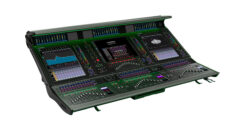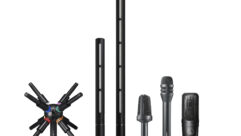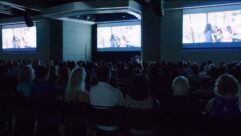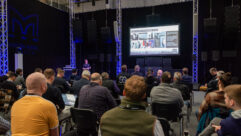
The Church at Rocky Peak Achieves Digital Audio with Yamaha Consoles
Aug 16, 2007 8:00 AM

Click here for more houses of worship news from The Briefing Room
Founded 30 years ago, the Church at Rocky Peak has occupied its current site on 115 acres in the rocky foothills of Chatsworth, Calif., since 1986. Two years ago, with a shift in style from large vocal groups to guitar-based praise music, the sound system in the 1,100-seat sanctuary, installed in 1997, began showing its age and consequent inadequacy to handle the new musical program.
“The church began seeking input from within the congregation,” says systems designer, Matt Hyde, of Sound Advice in Chatsworth, who maintained the original system as well as adding acoustical treatments to the sanctuary in 1997.
The change in music styles to a more contemporary, guitar-driven (in the manner of David Crowder or Chris Tomlin), and more participatory worship style caused very few problems for the congregation. But it did challenge the mixing skills of the church’s audio volunteers.
“To overcome the deficiencies of the room and the sound system,” says one of the church’s worship pastors, Dustin Kleinschmidt, “the mixes became louder.” The sanctuary is more than twice as wide as it is deep, and coverage was by an LCR cluster system, not the ideal choice for the space.
The new musical focus also involved the church scaling back on special large productions that were time-consuming as well as expensive to produce, to concentrate their efforts and resources on producing consistently high-quality sound every weekend.
Digital Decision
A longtime Pro Tools user, and very familiar with digital consoles in the studio environment, Hyde gradually became convinced that the digital format was viable in the live sound arena. “The interfaces are simplified enough to where you could move around quickly,” he says. “But the ability to impart your mixing wisdom by saving settings to the computer is what really sold me on digital consoles as a solution in the worship environment, even for churches without a sophisticated sound department.”
For Hyde, the Yamaha M7CL digital console hit the mark, making the technology easy enough to use for a non-professional, while retaining the sophisticated features that digital is capable of.
In fact, the systems that Hyde specified and installed is entirely Yamaha: from the M7CL console, through the DME24 DSP unit (via the console’s 16-channel in/out AVY16–ES card and Cat-5 cabling), to amps, and the company’s IF and IS series of installation loudspeakers.
“Yamaha’s whole approach to the live sound package—from console to amps to speaker systems—makes system integration much easier,” Hyde says. “You don’t have to go shopping from brand to brand, and you have everything at your disposal that you need.”
The Sanctuary and the System
The 1100-seat sanctuary of the Church at Rocky Peak is approximately 150’x63’ from the lip of the platform (76’x30’) to the mix position very near the rear wall. The room is 25ft. high at its highest point. The FOH speaker system consists of three Yamaha three-way installation speakers (1F3115/64s), and six two-way speakers (three IF2215/64s and three IF2208s as fills) in an exploded
cluster mono configuration. They are supported by four low-frequency (33 Hz to 95Hz) cabinets, two per side. All the Yamaha three-way and two-way speaker models have rotatable horns (60°x40° or 90°x50°). The Rocky Peak system is configured in a 60°x40° vertical array.
“We did a rough A/B demo with the Yamaha speakers against the existing system” Hyde says. “But it was so night and day that it was a no-brainer, especially the Yamaha 3-way speaker.… I find the Yamaha speakers to be extremely articulate and responsive even at moderate levels.”
Technology and Pastoring
“Part of my approach is that I just don’t go into a house of worship, install equipment, then leave,” Hyde says. “I stay there for a substantial amount of time and integrate the equipment into the church’s style of worship service. The console is really a blank canvas. I format it to the way the client likes to work, then I mix a few services so that I can set the EQ and compression, and voice the speakers…. But the whole process is as much an art as it is a technological skill, and requires my personal involvement, connecting with these churches and their people.”
Working with volunteer mixers in training sessions is, of course, another means of connecting with the style of each individual church client. Getting all those volunteers in the same place at the same time only really happens on Sunday (and sometimes for Saturday services or Thursday rehearsals).
“As much as you might think digital would be scarier, it’s actually turned out to be a blessing, especially with the way Matt approaches training. We use the sanctuary during the week for other events. Matt’s usually here for Saturday services overseeing the mixers, offering advice. So the ability to save settings saves us hours of setup time, and leaves more time to volunteer training.”
“When we talked to Yamaha about the console,” Kleinschmidt says, “we had two criteria: We wanted the highest quality of sound, and we wanted technology that could be managed by a volunteer staff.” Though it had once considered hiring a professional audio engineer, part-time, to handle services, the church decided that it really wanted to empower its own. “The volunteers have learned a ton about live engineering that they never would have experienced otherwise,” Kleinschmidt says.
With four bands playing at weekend services, each with its own style and sound, there’s plenty of opportunity for volunteers to practice and test their mixing skills, while not being taxed with building a mix from scratch. “We capture and store a base mix for each band and each band member as a start-point,” says church technical director Andy Thomas. “We set EQ and compression, for example, for the particular style of a band’s drummer. From week to week that drummer’s sound may vary a bit, and a mixer can adjust for that if he chooses. But the base start-point is always there, saved to the console.”
Thomas adds that the console’s flexibility can be used to accommodate mixers at a variety of skill levels—both for weekend services, where a certain level of quality is expected— as well as for peripheral events, where an apprentice mixer might be given more leeway in establishing a good mix. And because the Yamaha loudspeaker system is so revealing, it’s easier now to get a good mix, Thomas says. Even minimal adjustments—EQ’ing a frequency 2dB, for instance—are clearly audible.— “But with all the processing power we have available,” he says, “we adhere to the basic principle of, ‘get it right at the source.’ If something doesn’t sound as good as it could, it may be the arrangement, or the particular sound from the tuning of the drums, or a mic adjustment, or an EQ adjustment on a guitar amp. You can’t rely on the board being the doctor that fixes everything. You have to go back to the source.”
Given the volunteer structure, a certain variability of the mixes is to be expected. But in general, the digital console levels the playing field, Kleinschmidt says. “The console minimizes the potential for errors,” he says, “and it provides a kind of digital safety net for learning. If our guys feel that we’ve got their backs, they love the idea of jumping right into a whole new environment with both feet.”
There’s much more going on here with the use of digital technology than an attempt to achieve technical perfection. “The people come first,” Kleinschmidt says. “In the long run, I don’t think that when we get to heaven God is going to say: ‘Great job mixing last weekend.’”
Audio and the infrastructure for video are the focus now at Rocky Peak; video upgrade and additions will come later this year. But for the time being, the continuity in quality from weekend to weekend that the digital medium has allowed, and the opportunity for the church to empower its own through tech training, has given Rocky Peak all that it asked for from its new sound system.
For more information, visit www.yamaha.com/ca.










